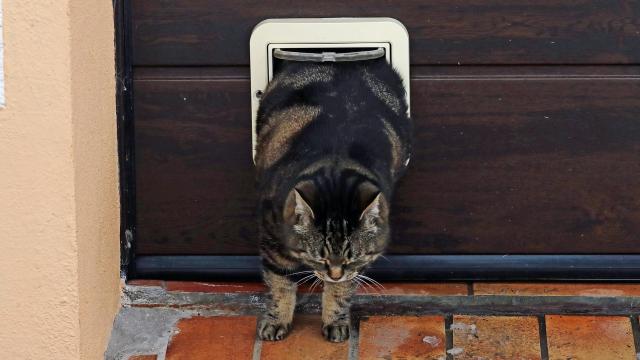Putting a cat on a diet is hard. The pitiful eyes, the constant yowling, the nonstop paw taps asking for food, not to mention all the times they wake you up at 2 a.m., in the hopes your guard will be down just enough that you’ll feed them. Add in a second cat with different dietary needs and it can seem impossible to make it work.
Lately, I’ve been in this predicament: Like many of us, my cat Cement has put on a few pounds in the last year, going from an already cement-esque 8 kg to a mega-chonking 10 kg, probably because his only exercise consists of stealing our smaller cat’s food. Something needs to change before he starts developing health problems or our smaller cat decides he’s had enough of all the food-stealing and finds a better family.
So if one of your cats is looking a little bit too thick, what do you do?
Implement strict meal-times
One answer is to structure their food intake with designated meal-times, with your cats either eating in separate rooms or at different times, in a setup that prevents the other cat from accessing the “dining room” during that time. For example, one cat could eat their meals in the bedroom, while the other cat eats in the home office at the same time. If your home is on the smaller side, meal times could be at separate times, but using the same room; just keep the door closed while one cat eats and the other stands outside, yelling to be let in. The important thing is to create a physical separation that will keep them from eating each other’s food.
If you go with set meal-times, the problem will be getting your cats to adjust to the new feeding schedule. If they are used to nibbling all day, it will be hard in the beginning. To soften the shock, keep the meal-times run on the longer side, allowing them more time to graze, and give them smaller meals more frequently, gradually reducing the number of times a day you give them food.
If you are switching to a diet food at the same time, it’s important to remember that whenever you introduce your cats to a new type of food, you need to do so slowly, or they can experience digestive issues. For the sake of your litter box (or your couch, carpet, or rug), start by mixing a little bit of new food with their regular food, adding a little more of the new stuff each day.
Distract them with puzzle feeders
One possible solution for distracting your hangry cat is to get some puzzle feeders, which are toys that you can load with a few pieces of dry food. To get at the food, the cat has to figure out the puzzle. Assuming your cat doesn’t give you the death stare for treating them like a rat in a maze, this can help them adjust to the new feeding schedule and deal with boredom.
Put food where only one cat can access it
If the thought of trying to make your cats stick to specific meal-times still makes you twitch, another solution is to put the smaller cat’s food in an area the bigger cat can’t reach. For example, my friend Jon put the smaller cat’s food on top of the fridge, where his bigger cat couldn’t jump. There are also pet feeders that will only open for a designated pet based on their microchip, a fancier way to keep their food separate without having to resort to scheduled meal-times.
If one of your cats has specific dietary need, this is a good way to ensure your cats don’t sample one another’s food. Of course, there’s still nothing you can do about being woken up at 2 a.m. by a hungry cat. That’s a problem you’ll have to figure out on your own.

Leave a Reply
You must be logged in to post a comment.